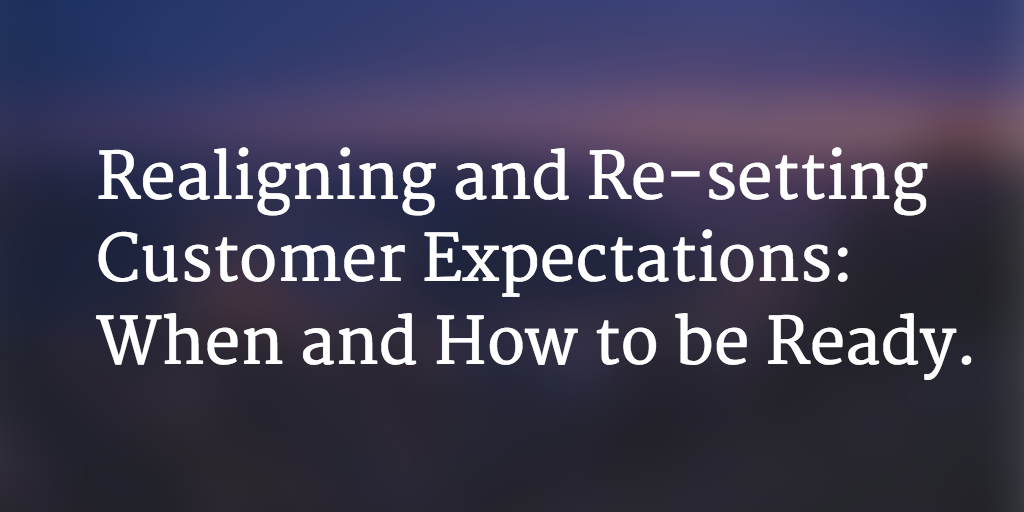Over a decade and a half spent serving in account management and marketing strategy roles at b2b ad agencies, I’ve learned the art of successful expectation management. For customer
success practitioners, knowing how to set customer expectations post- purchase, and
then throughout implementation has become a standard practice. But, it’s naive to
think that those expectations are static. They never are.
Your customers change. Their business is dynamic and shifts with the market. There are
personnel changes that lead to business changes – strategic and tactical. Your business
changes too. New features get rolled out, and some get retired. You have personnel
changes, which can also lead to business changes.
With change being constant from implementation to QBRs to renewals and beyond, it’s
imperative to know when and how to reshape, recast and reset how customer
expectations can be met.
Over the last year I’ve now spent leading customer success at Allbound, I’ve found
several key areas where the need to delicately realign expectations have emerged. I’ve
highlighted a few below, along with some tips to make that realignment work for you.
“Post Kick-off Hangover”
When you sign a new customer, everyone is excited. The customer. Your sales team.
Your CSM and technical teams. Everyone is sure they understand how the product will
get applied, what the implementation plan requires and can anticipate (almost to the
day) when that customer will experience their “time to value”. All of those notions are
celebrated at the implementation kick-off where the project plan is reviewed, roles
defined and responsibilities agreed to.
No matter how seamless the sales to customer success hand-off, every new customer
brings a perception and expectation for how your product will work for them. Often,
that expectation may even transcend what they saw and heard in the series of demos
and discussions they had with your sales team. Once they move from the vision to the
reality of working with your product, those expectations can shift.
What changed? Learning. Your customer starts to gain a greater understanding of how
your product works. As a result, it becomes more and more clear how the product will
manifest itself in their everyday lives. Those realizations can result in aha moments of
excitement, but can also create disenchantment over functional limitations they hadn’t
expected.
Resetting Expectations. When customer learning results in realizations about what the
product can’t do, it’s important to reset expectations by restoring focus on the
customer’s desired outcome. Doing this is as simple as following the old adage of
honesty is the best policy. Cliché right? Perhaps, but it is the easiest way to shift their
focus back to why they purchased in the first place.
Acknowledge their challenge – should the product do what they thought? Maybe. Could
it eventually? Perhaps. Does it stand in the way of them being wildly successfully with
your product? No…well, hopefully not. The point is that through in-depth learning about
your product, customers will find gaps in the offering. Don’t cover them up or gloss over
them. Address them head on and then reset focus on the features and functionality that
get them to their desired outcome.
‘Mid-Implementation Ideas Fallout’
As your customers continue to become better acquainted with your offering, they’ll
inevitably come up with ideas about enhancements that would benefit their particular
use case. My email inbox and nearly every customer status call is full of ‘what if the
system could’ or ‘wouldn’t it be great if’ ideas. This is all great perspective and feedback
of course. And, let’s agree that this sort of customer-driven ideation is one of the
valuable outcomes of having a strategic customer success practice.
What changed? A wave of new ideas can pose a challenge and a threat to the success
that customer will experience with your product. It becomes a distraction from what
your product CAN DO for them now. New ideas also become a list of what your product
doesn’t do, which really isn’t good (see section above).
Resetting Expectations. Without making promises that your product or roadmap can’t
keep, it’s important to acknowledge the ideas. My approach for this has been to
document “future ideas and phases” in a central place along with other critical customer
information like objectives, KPIs, business reviews etc. Essentially this documentation
becomes a living ‘expectation management’ document. That’s its intent.
By documenting those ideas and future opportunities, your customer feels heard. If it is
related to an available feature, tie the document to the cost and process to implement.
If it’s a roadmap item, record its target release and indicate if there is an opportunity for
that customer to be a beta user. Finally, if it remains in the parking lot for a while,
determine if it represents a custom services opportunity or a referral to a partner
services provider who can support the customization they are seeking.
The goal of this approach is to make the customer feel heard and to keep them
transparently and proactively informed of their options to see their ‘ideas’ come to life.
By placing it along side their KPIs and metrics, they can also self-balance their ideas with
how it adds value or detracts from what they are trying to achieve with your product.
‘Post-launch Loneliness’
Implementation of any product comes along with excitement and camaraderie.
Everything is so new and for an enterprise product like ours, implementation is a hands-
on endeavor. Weekly calls, dozens of emails and maybe even a few in-person meetings
lead to a high level of trust, but can it can result in a customer that is over-reliant on
your team. When the onslaught of regular interaction comes to a close, it can be
difficult for a customer to migrate to a place of self-performance. And, they’ll blame you
for leaving them unprepared and less than confident on how to independently use your
product.
What changed? Despite any training provided, customers quickly realize how daunting
and isolating the management of a complex product can be. Maybe they learned, but
are not yet proficient. Maybe they weren’t paying attention, so they are only realizing
how much there is to learn. And, while you’ve got a customer success plan to support
them over time, you’re already bogged down in the work you’re doing to implement
your next new customer.
Resetting expectations. This one is difficult, because it brings into focus the idea of
customer accountability that many customers just don’t want to accept. There is no
easy way to let someone know they should have paid closer attention, and you
definitely don’t want to give them the impression that you are too busy to help them
(even though you probably are). You could offer additional paid training or more
‘consultation hours,’ but at this stage, that suggestion is just going to create a greater
chasm in the relationship you worked so hard to create in implementation.
A successful approach can be to create a “Post-launch Success Plan” that includes an
expanded cadence of check ins- whether direct or as part of your customer marketing
strategies. Basically, take proactive steps to provide insights on their application and use
of the product over the course of quarter post-launch. What’s working, what’s not and
how they should be responding. The proactive nature of your outreach, either 1-to-1 or
via tech touches, will let you address the isolation that customer might be feeling. Your
goal should be to shift the customer perception that they’ve been left ill-prepared to
manage your product so that those feelings from becoming overtly negative.
The process of managing shifting expectations can at times put strain on the
relationships that customer success professionals need to forge. Creeping expectations
that go unaddressed or unmet lead to discontent and eventually, to churn. While
changing expectations are inevitable, two things that shouldn’t change:
- The primary objective and value the customer is seeking from your product.
- Your confidence in your product.
As long as these two things remain constant, the need to manage and reset
expectations becomes just another required skill in an effective customer success
methodology.
About Allbound
Allbound is mobile-friendly software that helps businesses track and improve the
performance of their indirect sales channels by automating the delivery of marketing
content, sales tools and training at each stage of the pipeline. With Allbound, businesses
can arm their resellers, distributors, VARs, agents, dealers, franchisees, brokers, reps
and retailers with the sales and marketing content, training and campaigns they need to
close more deals faster. See for yourself at www.allbound.com.

